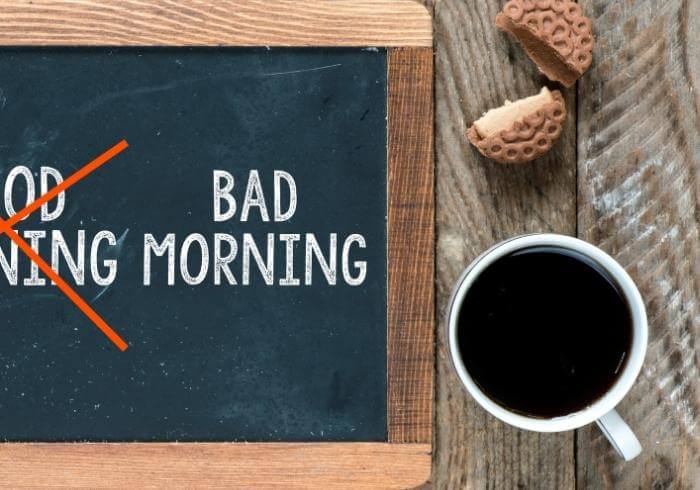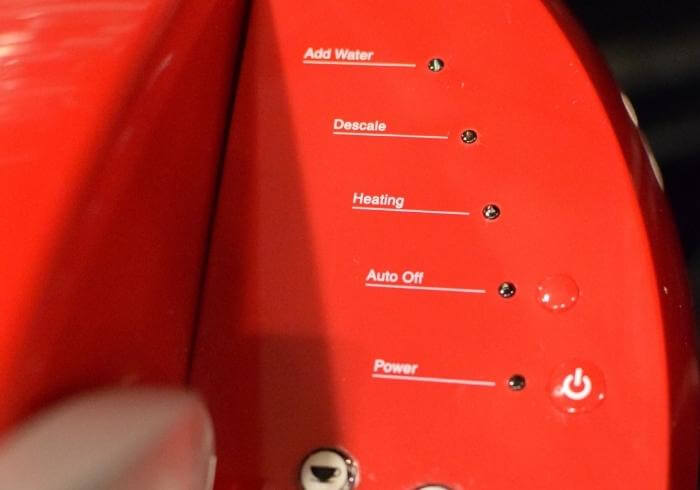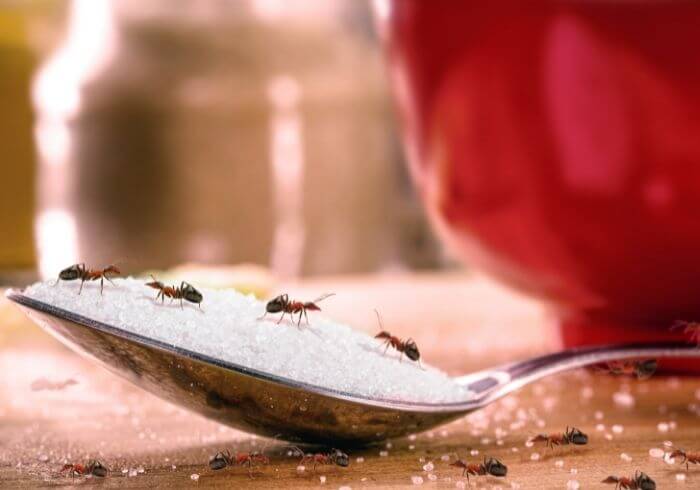French press coffee is a great option for those who like a stout coffee flavor but don’t have an espresso machine. Additionally, French press coffee is wonderfully tactile.
You need to grind your beans, wet them, stir them and then press your coffee once it steeps. All through this process, you can enjoy the delicious aroma of fresh ground coffee.
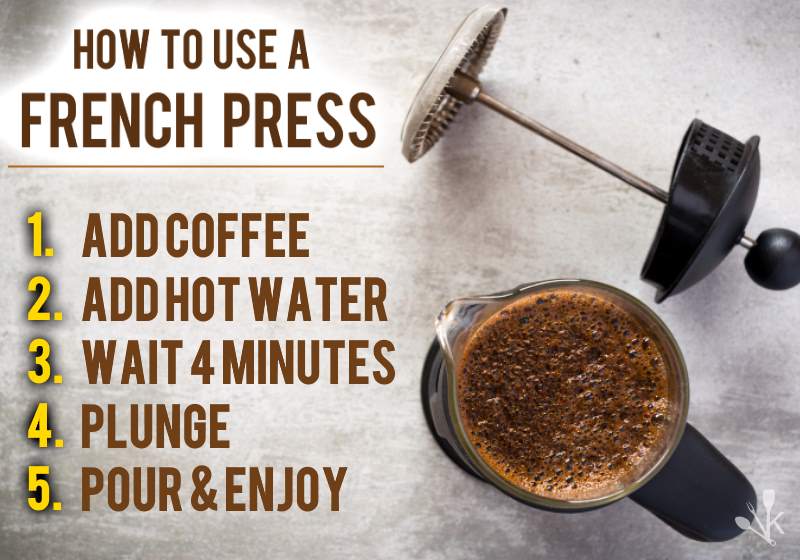
How To Use A French Press
You Will Need:
- Fresh roasted whole bean coffee
- A burr grinder, manual grinder or mortar and pestle. Don’t use a blade grinder; they produce too much coffee dust and will result in oily, gritty coffee
- A hot water pot, preferably with a long spout
- Fresh, preferably filtered water
- A wooden stirring utensil
- A small scale or measuring spoon
- A timer
- Your Best French Press
French Press Instructions
1. Rinse Your French Press
Bring your water to a boil in a long spout pot. Pour a few ounces of the hot water into your French press with the plunger in it to rinse and warm your pot, then wait 30 seconds to 1 minute for the water to cool and disgard before making your coffee.
2. Grind Your Beans & Add Them To The Pot
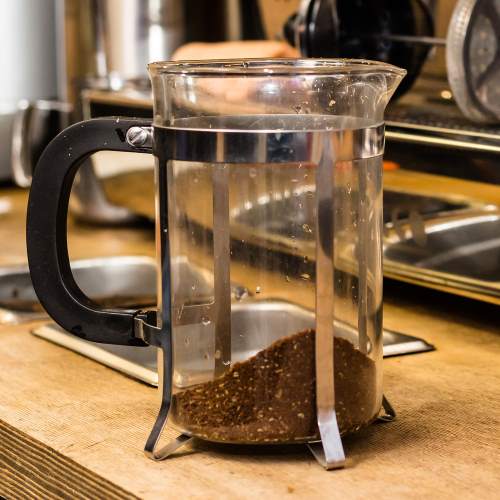
Grind your beans on the coarse setting or until it’s the texture of sea salt. If you’re grinding manually, you may want to start this while the water boils.
Add your coffee grounds to the pot. The French press coffee ratio suggested by experts with the National Coffee Association suggest 1 to 2 tablespoons of ground coffee per 6 ounce cup. As you use your press, you’ll find the best ratio for your favorite flavor intensity.
3. Add Hot Water Carefully
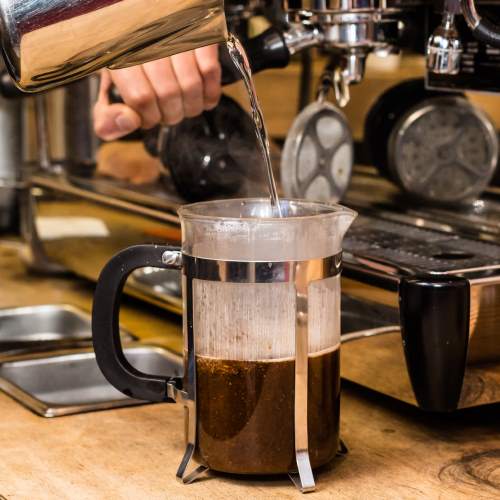
Pour just enough hot water over the grounds to wet them. Stir the grounds gently to make sure everything is immersed in hot water, and then fill your press with hot water.
4. Brew/Steep For 4 Minutes
Start your timer at 4 minutes. Cover the pot with the plunger mechanism to keep in warmth, but don’t plunge until the coffee has steeped for four minutes.
5. Plunge!
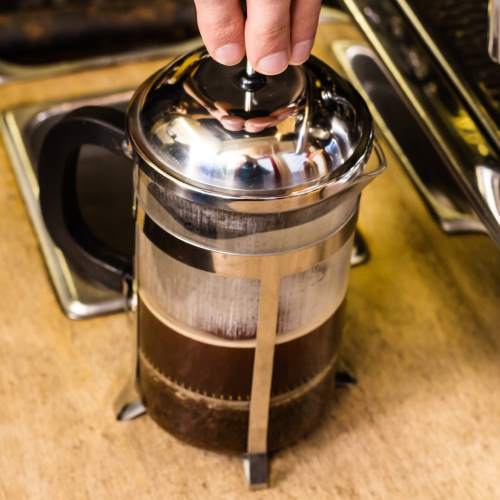
Slowly depress the plunger so the filters can do their job. French press filters generally have multiple layers for effective water movement while capturing all the grounds in the fine mesh.
If you force the plunger, you can damage the shaft or break the pot at worst, or just wind up with rather chewy coffee.
6. Pour and Enjoy!
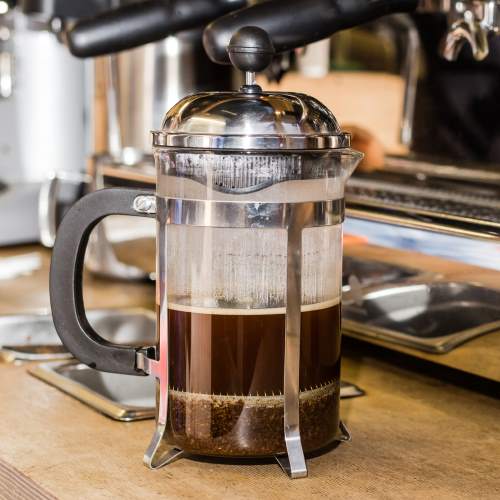
How To Make Cold Brew Coffee In A French Press
If you’re preparing a cold pot, the French press instructions are the same; just add cold water instead of hot.
The 4 minute French press timing requirement is also off the table. You can leave your French press in the refrigerator overnight, depress it in the morning, and enjoy delicious iced coffee.
SEE ALSO: Iced Coffee vs Brewed Coffee
French Press Coffee Water Ratio
As previously stated, you’ll need 1 to 2 tablespoons of coarse ground coffee per 6 ounce cup of brewed coffee.
If you’ve got a kitchen scale, experts with LittleCoffeePlace.com recommend a water to coffee weight of 15 to 1 as a starting point.
Of course, every taste is different, so feel free to experiment with different brews and berries to settle on the best French press flavor for your taste.
How much coffee do you put in a French press? If your coffee grind size is too coarse, it will take a lot of coffee to brew a rich, strong flavor. If your grind is too fine, you’ll wind up with cup of grainy, oily coffee.
For those with a friendly local coffee shop, consider buying your beans in small batches and ask them to give you a sample of coarse ground so you know what your home ground coffee should look like.
French Press Brewing Time
The four minute rule for hot water French press brew time is pretty universal. One of the interesting variances in this formula is if and when to stir your coffee grounds after adding water.
Some experts say to fill up the pot and stir vigorously; others say to only fill it part way and stir it gently. All agree that all the grounds must be incorporated into the water.
One of the most critical ratios to consider when brewing French press coffee is the French press water temp.
The optimal water temperature for French press coffee is 200 degrees Fahrenheit / 93 degrees Celsius.
Let the water rest after boiling for 30 to 60 seconds and you should be fine. If your coffee is weak, the water may be too cool. If your coffee has a bitter, nasty edge the water’s probably too hot.
SEE ALSO: What Makes Coffee Bitter?
How Does A French Press Work?
If you’re accustomed to a drip coffee maker, you know that filters hold fresh coffee grounds while hot water drips down over and through the grounds, resulting in hot coffee in the carafe below.
SEE ALSO: How To Use A Coffee Maker
A French press is also a combination of hot water, grounds and filtration, but the process is a bit more hands-on. It’s important to note that you can use your French press for hot or cold coffee, but cold French press only requires more time.
The difference between drip coffee and French press coffee is that French press coffee is manually filtered via plunger through stainless steel mesh rather than filtering it through paper via gravity.
Pros and Cons Of Using A French Press
Pros
- French press coffee never touches paper and can produce a wider range of flavors.
- Fresh ground coffee produces a fabulous flavor and odor, and you get to enjoy that odor while waiting for those 4 minutes.
- You also get to enjoy a luxury generally only enjoyed by cappuccino drinkers; that is, foam from the fresh ground beans.
Cons
- The plunging process can leave you with grounds in your cup that you never had to deal with from your old drip pot, but hopefully the flavor makes up for it!
- While your drip pot may go into the dishwasher, some French press pots must be washed by hand.
- You will need to stay with your pot for longer than if you’re used to a drip pot.
Safety Considerations
For those of us who are a little cognitive-challenged early in the morning, the process of handling a grinder, boiling water and a pot with a plunger can be a bit overwhelming.
Making coffee with a French press can be a little safer with the right tools.
For example, while former glass French press pots used to be rather fragile and easy to tip, there are several new units with well-balanced handles that reduce the risk of tipping and protect your knuckles from burns against the carafe.
Many new units also feature a button on the press shaft rather than just the round knob for easier depression and smoother action.
Finally, there are several French press pots that feature a thermal carafe instead of a glass pot. While these are much less likely to break, they also leave your coffee sitting on top of the grounds to steep long term, which may not give you the best flavor.
However, if you like these durable stainless steel French press pots, you might make a smaller batch of coffee and drink it soon enough that continued contact with the grounds won’t matter.
Final Thoughts
Brewing coffee is, chemically speaking, the act of extracting flavors and oils out of roasted, ground coffee and holding these compounds in suspension in hot or cold water so the drinker can enjoy them in solution.
This tradition is said to have begun in Ethiopia after a goat herder noticed his livestock becoming energized after eating the berries from a particular tree.
Over time, we figured out how to roast coffee beans. Depending on your flavor preference, both medium and dark roast beans work well in a French press.
What type of coffee do we recommend for French presses? A rich Colombian coffee bean in a medium roast. If you like strong coffee but don’t enjoy a bitter edge, avoid dark roast beans.
French press coffee is an elegant process that results in a remarkable beverage. It takes some focus and a steady hand while you handle very hot water early in the morning. It may not be the best option first thing in the day for many of us.
However, for a relaxing weekend cup of coffee, a French press is a lovely and useful tool. Additionally, once you get the hang of it on Sunday morning, you can start preparing this treat every day of the week!
Did you enjoy this guide? Let us know in the comments with your questions, favorite tips and tricks for brewing French press coffee.

